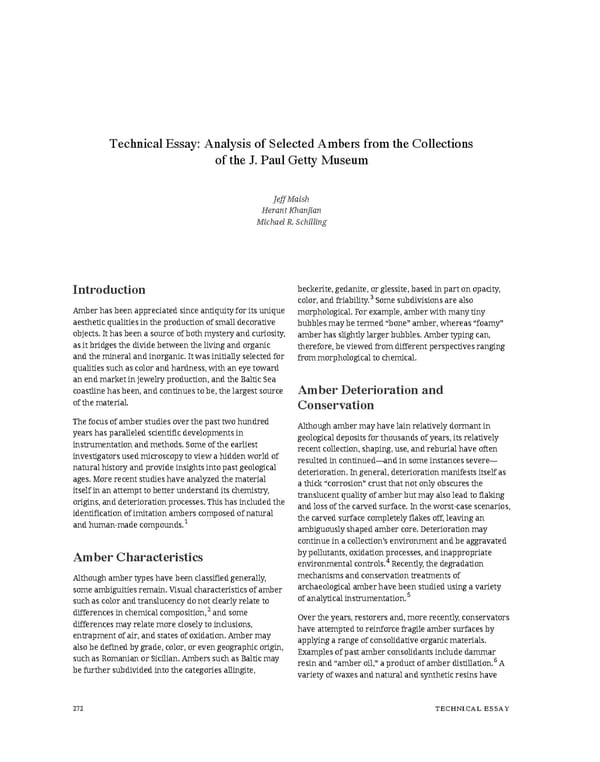Technical Essay: Analysis of Selected Ambers from the Collections of the J. Paul Getty Museum Jeff Maish Herant Khanjian Michael R. Schilling Introduction beckerite, gedanite, or glessite, based in part on opacity, color, and friability.3 Some subdivisions are also Amber has been appreciated since antiquity for its unique morphological. For example, amber with many tiny aesthetic qualities in the production of small decorative bubbles may be termed “bone” amber, whereas “foamy” objects. It has been a source of both mystery and curiosity, amber has slightly larger bubbles. Amber typing can, as it bridges the divide between the living and organic therefore, be viewed from different perspectives ranging and the mineral and inorganic. It was initially selected for from morphological to chemical. qualities such as color and hardness, with an eye toward an end market in jewelry production, and the Baltic Sea coastline has been, and continues to be, the largest source Amber Deterioration and of the material. Conservation The focus of amber studies over the past two hundred Although amber may have lain relatively dormant in years has paralleled scientific developments in geological deposits for thousands of years, its relatively instrumentation and methods. Some of the earliest recent collection, shaping, use, and reburial have often investigators used microscopy to view a hidden world of resulted in continued—and in some instances severe— natural history and provide insights into past geological deterioration. In general, deterioration manifests itself as ages. More recent studies have analyzed the material a thick “corrosion” crust that not only obscures the itself in an attempt to better understand its chemistry, translucent quality of amber but may also lead to flaking origins, and deterioration processes. This has included the and loss of the carved surface. In the worst-case scenarios, identification of imitation ambers composed of natural the carved surface completely flakes off, leaving an and human-made compounds.1 ambiguously shaped amber core. Deterioration may continue in a collection’s environment and be aggravated Amber Characteristics by pollutants, oxidation processes, and inappropriate environmental controls.4 Recently, the degradation Although amber types have been classified generally, mechanisms and conservation treatments of some ambiguities remain. Visual characteristics of amber archaeological amber have been studied using a variety such as color and translucency do not clearly relate to of analytical instrumentation.5 differences in chemical composition,2 and some differences may relate more closely to inclusions, Over the years, restorers and, more recently, conservators entrapment of air, and states of oxidation. Amber may have attempted to reinforce fragile amber surfaces by also be defined by grade, color, or even geographic origin, applying a range of consolidative organic materials. such as Romanian or Sicilian. Ambers such as Baltic may Examples of past amber consolidants include dammar resin and “amber oil,” a product of amber distillation.6 A be further subdivided into the categories allingite, variety of waxes and natural and synthetic resins have 272 TECHNICAL ESSAY
 Ancient Carved Ambers in the J. Paul Getty Museum Page 281 Page 283
Ancient Carved Ambers in the J. Paul Getty Museum Page 281 Page 283
